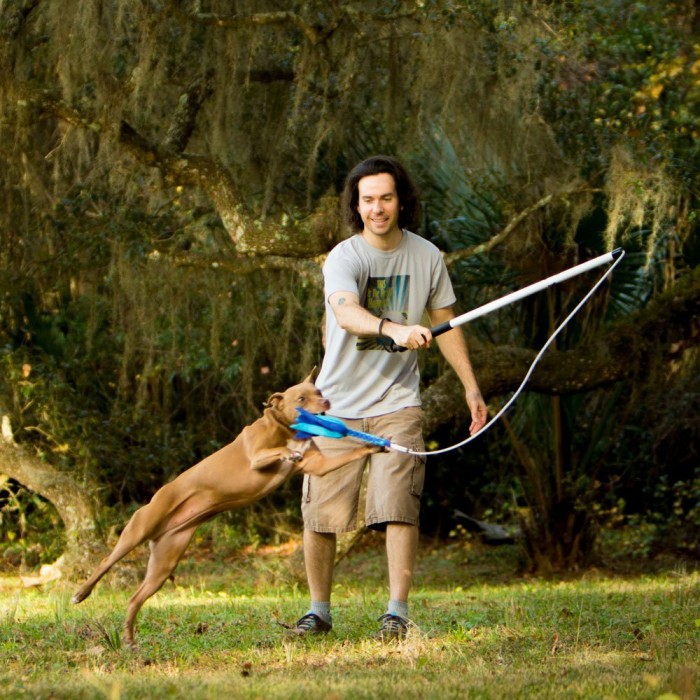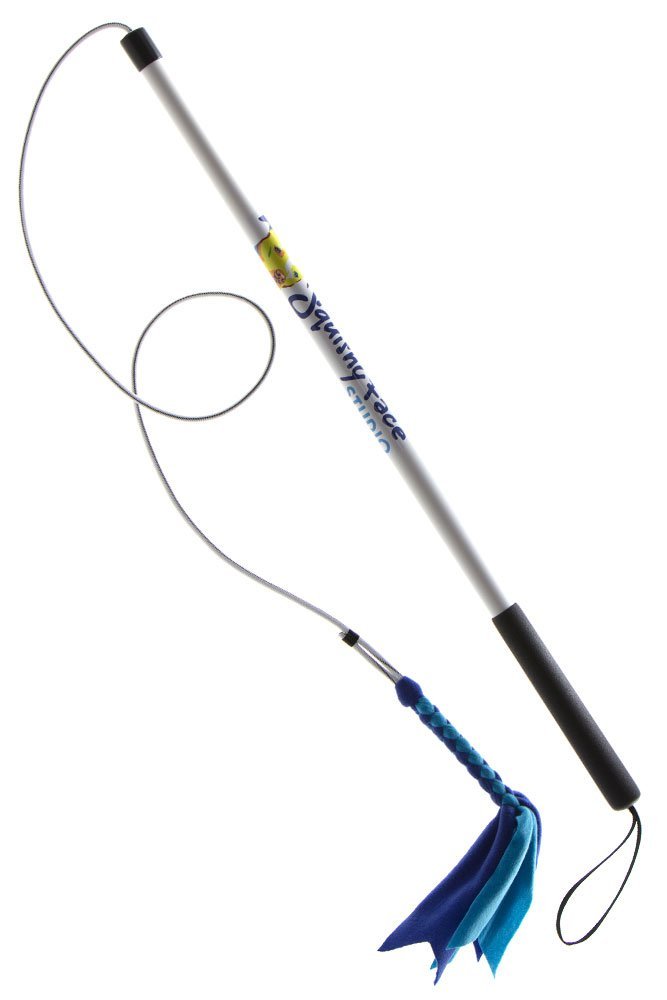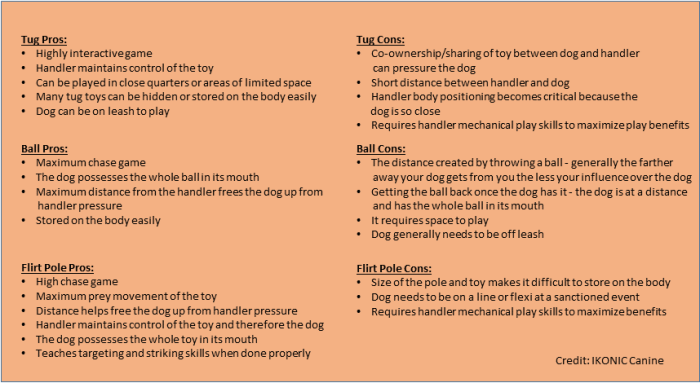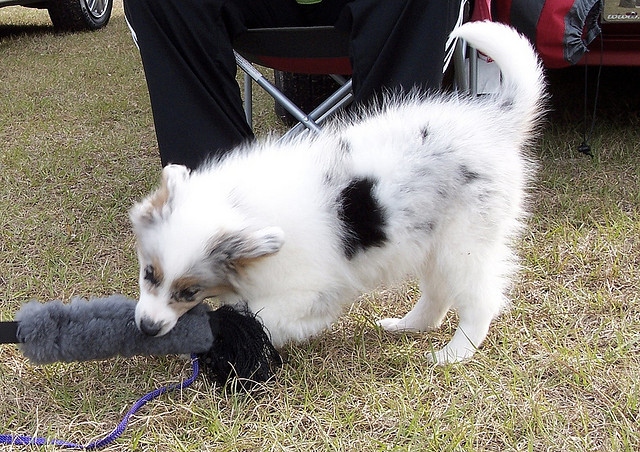I know, it sounds like something out of 50 Shades of Gray, but I promise it’s not. A flirt pole is a long pole with some type of rope attached to it and a dog tug toy at the end. These toys are amazing for play and exercise, but they are even better for training purposes.

What is a Flirt Pole and How Can It Help My Dog?
For many dogs, playing with a moving toy they can chase is the ultimate reward. For some dogs, it can even be too much. Does your dog tune you out whenever he sees something move? If you have a bunny, cat, or car chaser at home, you know what I am talking about. The flirt pole can help.
Learning Self-Control with a Flirt Pole
You can use a flirt pole to teach your dog that he only gets to play (chase) when you tell him. You can teach your dog he has to listen before, during and after a game. It’ allows you to control the thing that moves (trying doing this with a bunny or cat and the result will not be pretty) and only give it to your dog when he has earned it.
Kellie Whitehead is a dog trainer and owner of IKONIC Canine in the San Diego area of Southern California. Aside from six years of experience using the flirt pole as a training device, Whitehead worked with the Ruger, the dog featured in the video game Call of Duty: Ghosts and earned a formal credit as Assistant Director for training skills working as a dog handler and trainer for the TV Show Saving Private K9, which premiered last summer on The Sportsman Channel. She shared her tips and tricks with us.
Are there specific dimensions/lengths of pole and line that work best?
KW: When deciding on the best length of the pole, I consider the individual dog in front of me. Generally, I would recommend a pole approximately 48 inches long with a lash between 12 and 24 inches. If the pole is too short for the experience level or temperament of the dog, the toy may be close enough to the handler for the dog to feel inhibited, or the ideal prey movement to pique that particular dog’s interest may not be achieved. If the pole or lash are too long, it may become heavy and unwieldy for the handler, also making it difficult for achieving ideal prey movement – not to mention becoming too heavy for the handler to enjoy the game!
You can buy a flirt pole, like this one from Squishy Face Studio or you can make your own using a lunge whip and any toy your dog likes. (see our full review of the best flirt poles for dogs here.)

What are the advantages of using a flirt pole over something like a regular toy in training?
KW:A “regular toy” in training can be a tug toy, which is an object that is shared with the handler – the handler is also holding the toy at the same time the dog is. It can also be a ball or thrown toy where the dog has a lot of freedom. With a flirt pole, the dog has complete possession of the object in its mouth…but the handler maintains the ability to continue to keep the object alive and therefore continue the reinforcement process to include making the prey object run away should the dog lose possession of the object. All three have pros and cons, and it is really beneficial to the handler to understand them when selecting toys to use for training!

In my opinion, the ideal progression would be to introduce a dog to play on a flirt pole, then over time shorten the length of the pole, then switch to a long tug toy, then finally to the training tug toy for the “Tug Pro” reasons listed above, with ball play being a special reward if the dog enjoys it. Some dogs enjoy the flirt pole but never become interested in shorter toys, and that’s okay too! Something to keep in mind is that the dog decides what is most reinforcing to it. It is our job to listen and to structure our play to create the highest value game. The higher value our play, the higher value our reward for work…when paired together well, this equals great work! There is a reward for every dog
What are some “rookie mistakes” when working with toys as rewards?
KW:The distance allowed between the handler and the dog and toy on a flirt pole helps to take the handler’s influence out of the equation and allow to the dog to concentrate on the toy and channel their focus and effort into a specific target.
Remember, it is the chase we are after with this toy, and this activity appears to help increase a dog’s confidence level!

One of the most common issues I experience with people attempting to play with their dogs is that handlers like to be very helpful! They like to help the dog catch the toy or hold on better by pushing the toy toward the dog’s mouth. Keep in mind the toy at the end of the flirt pole is like bunny…and bunnies are highly effective at being evasive as should the toy always try to keep the toy moving away from the dog and abstain from becoming patterned with our movements.
I encourage people to make the chase of the toy on the flirt pole challenging yet attainable for the dog – if they try hard to catch the toy they should get it…but only because they legitimately caught it and not because the bunny had a death wish!

Another common issue I experience with people trying to play with their dogs is handler pressure or forcing the issue with the dog and not letting the natural progression of the dog finding and discovering the joy in the chase. Often handlers are unaware that they are getting in the way of allowing the behavior occurring. For example, frontal presentation is when we fully face our dogs and show the dog the front of our body. Instinctively this is uncomfortable for dogs because this is a threatening posture. Yet more often than not, people try to tug with their dog at a short distance while facing their dog…this is understandable since we want to see what our dogs are doing! Unfortunately, this body positioning tends to inhibit our dogs, but the flirt pole allows us to maintain a distance so that our body pressure isn’t as large of an impact on the dog. Given the length of the toy, we can work on counter conditioning our various body presentations and spacial pressure.
There are countless combinations of moving closer and farther away from the dog, up and down the line of the pole while tugging with your dog, and turning all different sides of your body. I want to work to the point I can move in close to my dog while tugging without my dog showing a change in behavior (re-gripping the toy, loosening their grip, and growling on the toy are just a few examples)…a change in behavior indicates the dog is uncomfortable and you did too much. When my dog is reliably chasing the toy, confidently grabbing it, and gripping and tugging well as I move up and down the line, I will consider progressing to a shorter pole or line.
What are your helpful hints for people wanting to try a flirt pole with their dog?
KW: Tips for maximizing your dog’s flirt pole experience include:
- Always keep the toy moving away from the dog
- As best you can keep the toy moving in straight lines – you can flip the toy away from them and go back the opposite direction if they don’t catch it
- Moving the toy in a circle around you creates a dog who plants themselves in the middle of the circle to cut off the toy and reduces the chase element we are looking for
- Be quiet while the dog is chasing (often we can be distracting and overwhelming)…save your enthusiasm for when your dog has grabbed hold of the toy
- Turn and show your side to your dog when you begin tugging to reduce handler body pressure
- Tug gently and reinforce your dog for pulling against you! This means allowing your dog to pull you by the toy or letting the line slide through your fingers so the dog feels like its “won”
- Have an “All Done” cue when you want the game to end and use a food exchange to take the toy away
Training Video: Flirt Pole Basics from BADRAP.org:
What are some simple exercises to get started with using a flirt pole to help with self-control?
KW: Self-control in the face of any high value reward is usually challenging for dogs. Initially, I recommend handlers ask for very little before a fun flirt pole game so the dog can be successful, then shift criteria over time asking for more from the dog before the game begins.
An early exercise might be to hold the toy behind your back and ask your dog to sit…when the dog sits, mark the behavior with a sound or a word before moving your body so that you achieve a clean release, then move the toy to begin the game.
Shifting criteria includes:
- Increasing the duration of the sit before releasing to play
- wait for the dog to offer eye contact in the sit before releasing to play
- slowly bringing the toy from behind your back into sight while the dog holds the sit and then releasing to play
- slowly bringing the toy from behind your back into sight and then lowering it toward the ground before releasing to play
….and continuing in time to increase your distance, duration, and distractions.
I highly recommend training the dog to sit on a platform and reinforcing it until the behavior is strong. Giving the dog the task of sitting on the platform while working on its self-control with the flirt pole really helps to anchor it in position and be successful. I hope these ideas help!
Learn More by Searching & Comparing Amazon for “Dog Flirt Poles”
 Toledo, United States.
Toledo, United States.